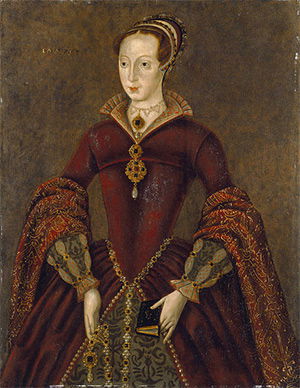Lady Jane Grey Proclaimed Queen
The Nine Days Queen was pronounced monarch on July 10th, 1553.

Thin and freckled with sandy hair, and so short that she wore elevator shoes, Lady Jane Grey was Henry VIII’s great-niece. She was born in the same month in 1537 as his son and successor, Edward VI, and her ambitious parents, hoping to marry her to Edward one day, paid special attention to her education and brought her up a convinced Protestant. A bookish intellectual, she was quite unable to cope with the real world and with being a pawn on the political chessboard. It was an extremely dangerous chessboard.
The virtual dictator of England under the sickly young Edward was John Dudley, Duke of Northumberland. By 1553 Edward was clearly unlikely to live much longer. Northumberland knew that if Edward’s sisters Mary or Elizabeth took the crown, his days in power would be over and Mary would restore Roman Catholicism. He decided to put his own family on the throne and in May he had the fifteen-year-old Jane married, against her will, to his fourth son, Lord Guilford Dudley, who was about the same age. Jane went straight back to her parents, but as the King grew weaker, Northumberland ordered the marriage to be consummated, and it was.
Northumberland persuaded the dying Edward to declare Mary and Elizabeth illegitimate and transfer the succession to the Lady Jane. The royal council, which viewed Northumberland as mice do a cat, accepted the decision, with misgivings. Jane was told, but apparently did not take it in. Mary and Elizabeth were summoned to the dying king’s side at Greenwich, where they could most easily be neutralised. Mary set out, but the shrewd Elizabeth took to her bed and said that she was ill.
Edward died on July 6th. Mary, on her way to Greenwich, was warned of the trap and rode pell mell for Norfolk. Elizabeth stayed in bed. The King’s death was kept quiet and on July 9th Jane was taken to Northumberland’s mansion outside London, Syon House at Isleworth, where the Duke, her husband and her parents were waiting with members of the council, who to her surprise treated her with immense deference. Northumberland announced that she was queen and she fainted before, with the utmost reluctance, accepting the throne ‘if what has been given to me is lawfully mine’. The following day she was proclaimed by heralds with flourishes of trumpets at various places in London, to the stony disapproval of the citizens. One man who incautiously said the Lady Mary had the better right had his ears cut off.
In the afternoon Jane arrived by barge at the Tower, tried on the royal crown, which made her feel faint again, and had a blazing row with her husband and his mother when she said she would not make him king. The banquet that evening was spoiled by the arrival of a letter from Mary to the council firmly asserting her right to the throne and demanding immediate support.
Jane continued going through the motions as queen in the Tower, but Northumberland had miscalculated badly. The Lady Mary was well liked (she had not burned anyone yet) and he was not. Mary’s support grew and she gathered a sizeable army, while Northumberland’s men deserted. So did the council in London. By July 18th only three of them – including Jane’s father – remained loyal to Northumberland. The others left the Tower on the improbable excuse of urgently needing to talk to the French ambassador and had the lord mayor of London proclaim Mary next day. Her father told Jane she was no longer queen and she said she was delighted to hear it and could she go home, please?
Poor Jane had been queen for nine days and there was no question of going home. She was held prisoner in the Tower while Northumberland was arrested and her parents hastily made their peace with Mary. Elizabeth left her bed of sickness and arrived in London on the 29th to greet the triumphant Mary, who reached Aldgate on August 3rd as trumpets blared, cannon boomed, bells rang and citizens cheered themselves hoarse.
Northumberland was executed for high treason three weeks later. Jane was considerately treated in the Tower, but when her father witlessly joined Sir Thomas Wyatt’s rebellion in January, Jane was considered too dangerous a focus of plots to be allowed to live. She and her husband went to the block on February 12th, 1554. She was sixteen years old.